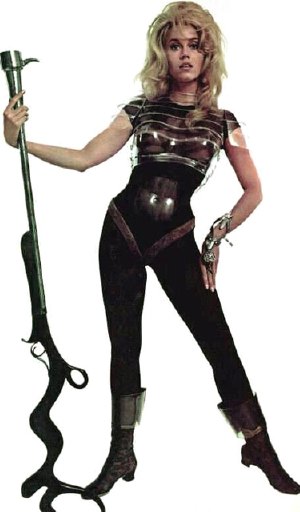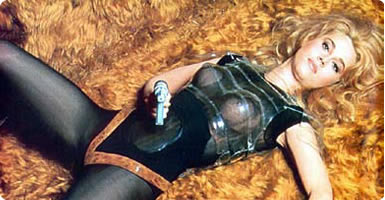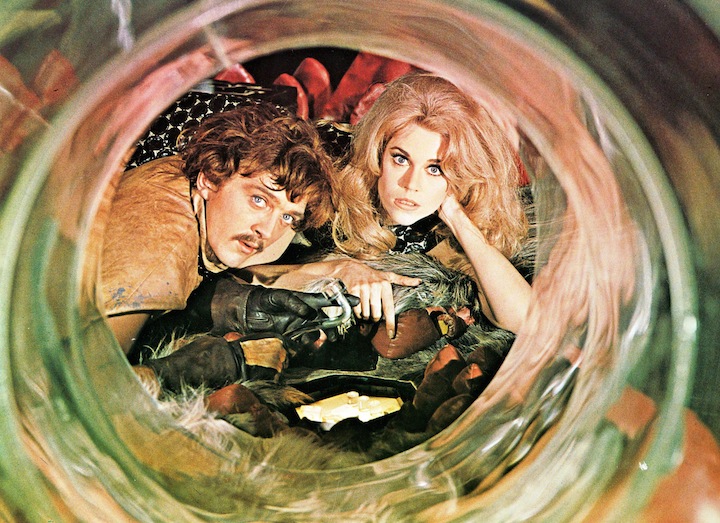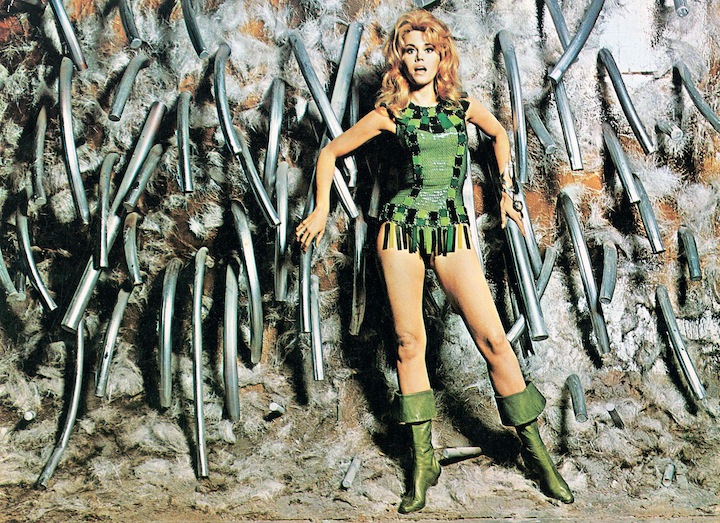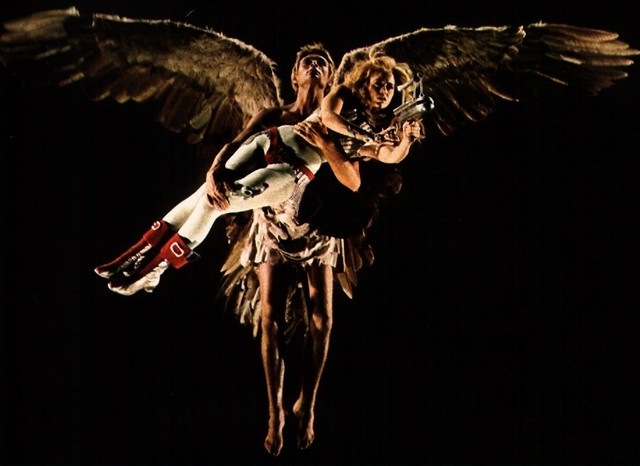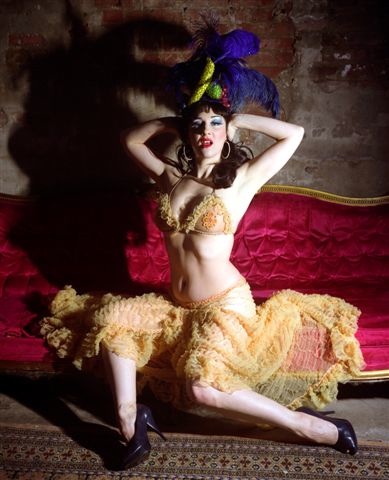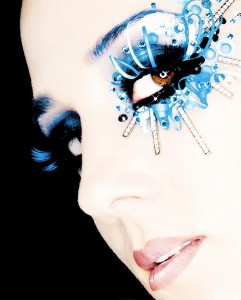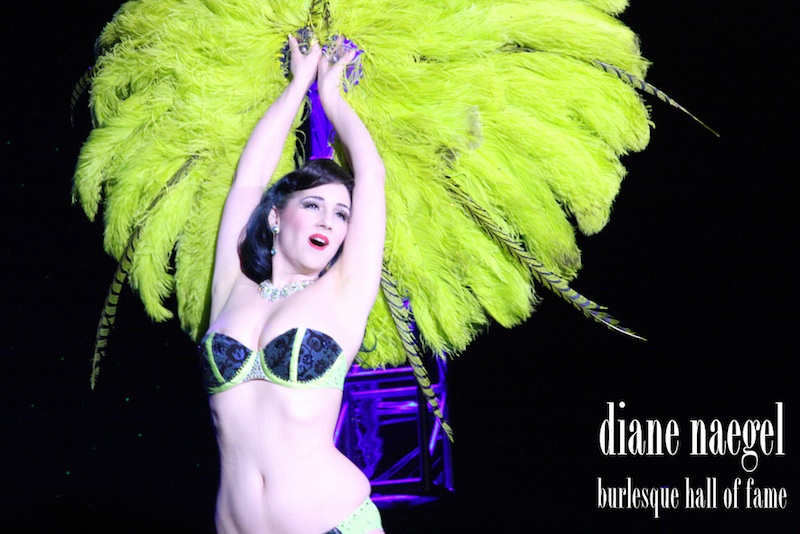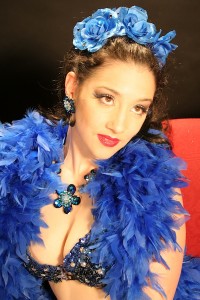 BARBARELLA (1968); Dir: Roger Vadim; Screenplay by Terry Southern; Based on a bande dessinee by Jean-Claude Forest; Starring Jane Fonda, John Phillip Law, Anita Pallenberg, David Hemmings, Milo O’Shea, Marcel Marceau; Plaza Theatre, Saturday, January 26 at 10:00pm; presented by BLAST-OFF BURLESQUE’S TABOO-LA-LA with live stage show before the screening including raffle of 10 8×10 signed photos of Fonda as Barbarella from Jane Fonda’s personal collection; Trailer here.
BARBARELLA (1968); Dir: Roger Vadim; Screenplay by Terry Southern; Based on a bande dessinee by Jean-Claude Forest; Starring Jane Fonda, John Phillip Law, Anita Pallenberg, David Hemmings, Milo O’Shea, Marcel Marceau; Plaza Theatre, Saturday, January 26 at 10:00pm; presented by BLAST-OFF BURLESQUE’S TABOO-LA-LA with live stage show before the screening including raffle of 10 8×10 signed photos of Fonda as Barbarella from Jane Fonda’s personal collection; Trailer here.
By Robert Emmett Murphy Jr.
Special to ATLRetro.com
BARBARELLA is a special kind of cinematic disaster. A lavish space-opera comedy released in 1968, the most important year in SF cinema since 1951, it had a $9 million budget, making it only modestly less expensive than the same year’s 2001: A SPACE ODYSSEY ($10.5 M) and more expensive than that year’s PLANET OF THE APES ($5.8 M). Meant to celebrate the era’s new found sexual freedom and the changing role of women in society, BARBARELLA is one of those films in which the first five minutes tell you everything you are going to get, as well as promising you all the things it should’ve given us and simply failed to deliver.
The opening image is a lovely array of stars, and hanging within it an improbable and more than slightly feminine-looking space ship. We move in closer until we can see through a portal into the fur-lined cockpit…
Full stop. Christ, I can’t believe I just wrote that: “fur-lined cockpit.” You know that whoever came up with that idea was thinking ahead to an exhausted film reviewer of a more innocent age, sometime after midnight hammering out copy and tearing his hair out screaming, “HOW CAN I GET THIS PAST THE EDITORS!”
OK, so we can see through a portal into the fur-lined cockpit where a space-suited figure floats in a really excellent simulation of zero-gravity (also a simple illusion, the astronaut is filmed from above while lying on a plexiglass platform). The identify is hidden behind a featureless metal helmet. But the material transforms from metal to clear plexiglass (another fine piece of simple FX, the reflective metal is actually a liquid in a space within the helmet’s bowel-like structure. It’s merely drained through the bottom.) revealing the “spaceman” is actually a not-quite-yet-30 Jane Fonda, never looking more beautiful. Her expression not only evokes a potent come-hither sexual promise, but more importantly, pure delight.
The music comes up. The song is deliberately silly (unafraid to rhyme “Barbarella” and “psychedella”) but quite catchy, celebrating the film’s title character’s sex appeal in a way that is far more joyful than crass. Though the film is based on a French comic book, it’s geared to an American audience, so before we hear her name (already legendary across the ocean), the singer compares her to our more familiar Wonder Woman.
Fonda/Barbarella strips off her space suit. It’s a sectional outfit revealing her progressively, teasingly. She is completely naked beneath. The animated titles escape the seams of the garment like venting gasses, swirling around her, protecting her immodestly. Except when they don’t. They keep trying to obscure, but she is happy to reveal. And the wantonness is now more than just promise; she expresses ongoing sexual pleasure (perhaps the caress of the letters?). Finally, wholly naked, she presses a button, tumbles down the luxurious furs, and she clearly is sated.
It’s one of the greatest stripteases in film history.
The next four minutes aren’t half bad either. The dialogue is witty and provides a lot of narrative context without excessive exposition. Barbarella immediately gets a call on her video screen from Claude Dauphin as the President of Earth. Their greet each other by saying “Love,” in what is clearly a political party’s salute.
Barbarella: “Just a minute. I’ll slip something on.”
President: “Don’t trouble yourself, this is an affair of state.”
In short order we learn that Barbarella is a secret agent in a future so perfectly utopian and groovy that she is rendered childlike in her naivete. She is assigned the mission to find an evil scientist named Durand Durand (yeah, that’s where the ’80s band got their name from) and stop him from supplying weapons to primitive peoples and threatening to disrupt the proper social order.
Barbarella: “Weapon? Why would anyone want to invent a weapon?…I mean the universe was pacified centuries ago.”
President: “What we know of it…We know nothing of Tau Ceti.”
Barbarella: “You mean they can still be living in a primitive state of neurotic irresponsibility?”
Sweet Barbarella seems only vaguely familiar with the concept of secrets (yeah, I know, she’s supposed to be a “secret agent,” but whatever) and can’t even say the word “war,” but instead babbles absurd multisyllabic euphemisms like “archaic insecurity” and “selfish competition.”
We’re now nine minutes into the film. After this point, there’s not a single Goddamn scene in the film that follows that compares, either in its sexiness, warmth of performances, generosity of humor, playful satire or technical achievement.
So why watch the remaining one and half hours?
I can think of three reasons:
1) The wonderfully creative and over-the-top costumes. Especially Fonda’s, who goes through a wide variety because since she’s constantly undressing, she is therefore constantly redressing.
2) The sets and props, which are even more impressively inventive than the costumes. I especially liked the aforementioned fur lined cock pit, the ice craft, the bird-shaped bird-cage that is the size of a small bus- well, the list goes on. Though the film showed little interest in evoking the title-character as she was presented in Jean-Claude Forest‘s comic strip, they did hire Forest as a consultant on the visuals. As wrote Graeme Clark: “[T]he film-makers’ maxim seems to have been, if it looks cool, if it looks weird, then put it onscreen.” And Gary Morris wrote, “[G]audy, colorful sets, looks like it was shot in the bowels of the Playboy mansion — especially our heroine’s spaceship, with its fur-lined walls that reek of ’60s softcore chic.”
3.) Maybe, deep down in your heart, you hate Jane Fonda, and want to just sit back, watch her flounder, and feel superior.
Yes, Fonda has never been more beautiful, but there’s no doubt this is her career worst performance. Despite being charming in the first scene, her performance quickly degrades, as she becomes increasing wide-eyed, vacuous and cold. I have to wonder why she gets worse the farther she gets into the film. I do know it was made in France at the most important transition point in her acting and political career (her follow-up film, the same year, THEY SHOOT HORSES, DON’T THEY? earned her first Oscar nomination, and by the time BARBARELLA was released, she’d embraced feminism and thrown her support behind the Native American occupation of Alcatraz Island). What I think happened is that in between takes she started listening to the babble of French intellectuals who analyzed the film’s actual content (and I should say, this is a film that shouldn’t be analyzed for content), and they revealed to her some uncomfortable things:
First, the bad guys are led by an arrogant intellectual who insidiously infiltrates and corrupts a primitive culture with the goal of undermining the larger community of peace-loving, wealthy, advanced societies. Meanwhile the good guys, also foreigners, are forced to intervene and also engage in infiltrating and saving the backward indigenous peoples through a nobler, but still newly introduced, ideology, military training and supplying advanced weapons. The good guys turn the indigenous people into a “third force” that will create a society more cooperative to the ideals of more civilized foreign powers. The overarching message is that if you want to preserve universal peace, start a proxy war. It’s almost Robert Heinlein-esque in the way the heroes are “forced” into engaging in foreign interventions. In other words, the movie is pro- the kind of Third Phase Imperialism that led both the USA and the USSR into the Vietnam conflict.
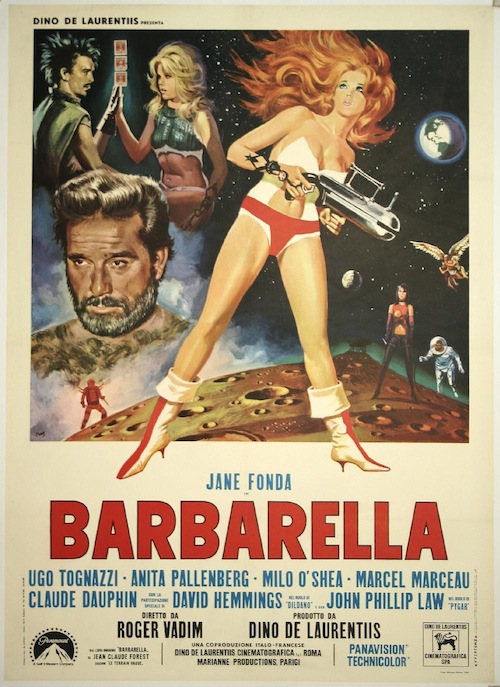 Ugo Tognazzi plays Mark Hand, the heroic Catchman, the guy who introduces Barbarella to the wonders of really good primitive sex. But he also spends most of his day using corporal punishment to discipline nasty, unsupervised, disrespectful children. He then rounds them up so they can be properly indoctrinated into their responsibilities to society. In other words, BARBARELLA the movie hates the youth culture.
Ugo Tognazzi plays Mark Hand, the heroic Catchman, the guy who introduces Barbarella to the wonders of really good primitive sex. But he also spends most of his day using corporal punishment to discipline nasty, unsupervised, disrespectful children. He then rounds them up so they can be properly indoctrinated into their responsibilities to society. In other words, BARBARELLA the movie hates the youth culture.
And it didn’t like homosexuals much either.
Women are completely objectified, and the heroine is an utter bimbo (which the comic-book heroine was not). Though she does heroic things, she doesn’t have an idea in her head or a goal worth pursuing that wasn’t planted there by an older, dominant male. Also, after arriving on the planet, almost all the “sexy” scenes concern her being captured and tortured. In other words, the movie is amazingly misogynistic right at the dawn of American feminism.
Also, I think even French intellectuals probably thought that director (Fonda’s then-husband) Roger Vadim, was a sleazy creep who was ruining her career with films like this. Vadim’s life reflected the films bizzaro sexual anti-liberation. He was a serial husband with a penchant for woman barely more than half his age and made a habit of trading eachwoman in as soon as responsibility reared its ugly head. Prior to Fonda was Brigitte Bardot (probably the inspiration for the comic book Barabarella in the first place), who was 15 to his 22 and whom he drove to several suicide attempts before their divorce. He left Bardot for the more age- appropriate Annette Stroyberg, but then abandoned her with a two-year-old child for Catherine Deneuve who was 17 to his 33. He was already involved with Fonda during that third marriage – when Fonda and Vadim first met she was 18 to his 27 -and when Vadim abandoned Deneuve, with their two-month-old child, to move in with Fonda she was 26 to his 35. The two would separate not long after BARBARELLA, leaving yet another child too young to walk. During that separation he would get involved with Catherine Schneider who was 26 to his now-44. There would be another two marriages after that.
Fonda would eventually disown the film. At the San Francisco Film Festival in 1994, she was asked “Where was her head?”
“I don’t know – up my armpit, I guess,” she replied. “We all make mistakes. In my case, I keep getting my nose rubbed them.”
Worse still, Fonda turned down the role of Bonnie in BONNIE AND CLYDE (1967) to do this stinker. Faye Dunaway eventually got that role, and an Oscar nomination. Fonda should’ve listened to Virna Lisi. When Lisi was told to play the part of Barbarella, she terminated her contract with United Artists and returned to Italy.
Episodic in the same way J.R.R. Tolkien’s work was, BARBARELLA lacked the master’s flair for the actual episodes, as well as being completely lacking in forward momentum. It displayed none of Tolkien’s warmth or affection for his characters, and notably Tolkien’s much-maligned female characterization was far better than what we see in this film with a higher percentage of prominent female roles. It wasn’t even close to Tolkien’s capacity to pull the divergent threads of plot into a meaningful climax.
BARBARELLA was panned in its day but has grown into a cult classic. Today, many critics are generous towards it because of its camp value, of which there is a great deal (It’s listed with the “Top 100 Most Amusingly Bad Movies Ever Made” in THE OFFICIAL RAZZIE MOVIE GUIDE), but I can’t help but be put off when watching a film that contains much to snicker about, but when it tries to tell an intentional joke, it generally falls terribly flat. Forest’s original comic book was fun, and the movie’s original script was by the great Terry Southern, but later critics seem unanimous that Vadim was more interested in his sexual obsessions than Forest’s swashbuckling adventurism or Southern’s omni-directional satire. As a result, no one in the cast seemed to be having any fun, and lines that really should’ve been been amusing come off stale:
Barbarella: “Make love [in a manner that involves actual physical contact]? But no one’s done that for hundreds of centuries!”
“This is much too poetic a way to die!”
“A good many dramatic situations begin with screaming!”
Mark Hand: “Are you typical of Earth women?”
Barbarella in a revealing costume made all the more so because it was shredded: “I’m about average.”
Pygar the angel (John Phillip Law, who if anything, a worse actor than Fonda in this movie):
“An angel does not make love, an angel is love.”
“But you’re soft and warm! We’re told that Earth beings are cold.”
And explaining why he saved the evil queen who tortured him: “An angel has no memory.”
I will credit one cast member with carrying on like a true soldier. David Hemmings, in an underwritten part as the inept freedom fighter Dildano, was quite good. He offered some hints of what this film could’ve been.
Also very fine was a captivating soundtrack by Bob Crewe and Charles Fox performed by The Glitterhouse which featured Pink Floyd guitarist David Gilmour.
Vadim wanted to do a sequel to BARBARELLA, but that dream died with his marriage to Fonda. He then talked about a remake right up to his death, toying with leading ladies like Drew Barrymore. Other directors have expressed interest in the remake project, notably Robert Rodriguez.
 In closing, I would like to recommend an exceptionally sophisticated homage to this really dumb film. CQ (2001) written and directed by Roman Coppola (son of Francis Ford) takes us back to Paris of the ‘60s where a young American filmmaker, Paul (Jeremy Davies), is trying to made personal art film/love letter to his girlfriend Marlene (Elodie Bouchez) but all that the honest camera can do is document her depression and resentments. So he gets a job assisting the director of an a cheesy sci-fi that is clearly a better version of BARBARELLA. That film’s director, played by Gerard Depardieu, is turning the project into a complete train wreck because he can’t come up with an ending, but really, can’t cope with the fact that the fantasy of revolution and liberty he creates on film will never translate to the real world. Paul gets drawn into the director’s lunacy through his growing infatuation with the film’s sexy star, played by Angela Lindvall, who remains the same impossible ideal of sexuality and liberty even when Depardieu’s camera is not rolling.
In closing, I would like to recommend an exceptionally sophisticated homage to this really dumb film. CQ (2001) written and directed by Roman Coppola (son of Francis Ford) takes us back to Paris of the ‘60s where a young American filmmaker, Paul (Jeremy Davies), is trying to made personal art film/love letter to his girlfriend Marlene (Elodie Bouchez) but all that the honest camera can do is document her depression and resentments. So he gets a job assisting the director of an a cheesy sci-fi that is clearly a better version of BARBARELLA. That film’s director, played by Gerard Depardieu, is turning the project into a complete train wreck because he can’t come up with an ending, but really, can’t cope with the fact that the fantasy of revolution and liberty he creates on film will never translate to the real world. Paul gets drawn into the director’s lunacy through his growing infatuation with the film’s sexy star, played by Angela Lindvall, who remains the same impossible ideal of sexuality and liberty even when Depardieu’s camera is not rolling.
Robert Murphy is 47 years old and lives in New York City. Formerly employed, he now has plenty of time to write about movies and play with his cats.

